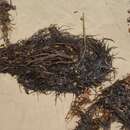en
names in breadcrumbs


Phyllospora comosa, known as crayweed,[1] is a species of brown algae in the Seirococcaceae family that is a type of temperate seaweed forest important as habitat for many marine species and also for producing oxygen and capturing atmospheric carbon. It is found in the oceans around Australia and New Zealand.[2] Crayweed grows up to 2.5 m (8 ft 2 in) in length and forms dense, shallow forests. It is abundant in cooler waters along the south-eastern coastline of Australia, around Tasmania and in South Australia and occurs to a depth of around five metres (16 ft) on the east coast and farther south to about three metres (9.8 ft). On some Tasmanian coasts it can occur depths of at 18 metres (59 ft). It used to occur around Sydney but has disappeared from metropolitan areas under pressure from human activities during the 1970s and 1980s.[3]
The algae have a central main axis, usually up to 3 m (9.8 ft) long, which bear many branches along their length, with closely arranged, leaf-like laterals. Some laterals have conceptacles, in which develop cells which produce sperm and eggs. The strongly seasonal growth of the algae depends on the length of daylight; it occurs from apical cells and is restricted to the top 20–30 cm (7.9–11.8 in) of the branches.
A conservation effort known as "The Crayweed Project" or "Operation Crayweed" is working to re-establish the species in the waters around Sydney.[3] Transplants have been established at sites including Malabar, Coogee, Little Bay, Freshwater and Bondi; other transplants are planned for Newport and Dee Why.[4]
{{cite web}}: CS1 maint: multiple names: authors list (link)  Phyllospora comosa on a beach on the southern coast of NSW
Phyllospora comosa on a beach on the southern coast of NSW Phyllospora comosa, known as crayweed, is a species of brown algae in the Seirococcaceae family that is a type of temperate seaweed forest important as habitat for many marine species and also for producing oxygen and capturing atmospheric carbon. It is found in the oceans around Australia and New Zealand. Crayweed grows up to 2.5 m (8 ft 2 in) in length and forms dense, shallow forests. It is abundant in cooler waters along the south-eastern coastline of Australia, around Tasmania and in South Australia and occurs to a depth of around five metres (16 ft) on the east coast and farther south to about three metres (9.8 ft). On some Tasmanian coasts it can occur depths of at 18 metres (59 ft). It used to occur around Sydney but has disappeared from metropolitan areas under pressure from human activities during the 1970s and 1980s.
The algae have a central main axis, usually up to 3 m (9.8 ft) long, which bear many branches along their length, with closely arranged, leaf-like laterals. Some laterals have conceptacles, in which develop cells which produce sperm and eggs. The strongly seasonal growth of the algae depends on the length of daylight; it occurs from apical cells and is restricted to the top 20–30 cm (7.9–11.8 in) of the branches.